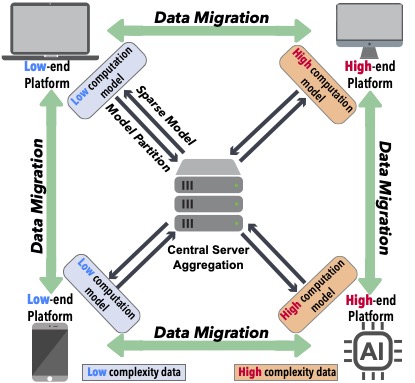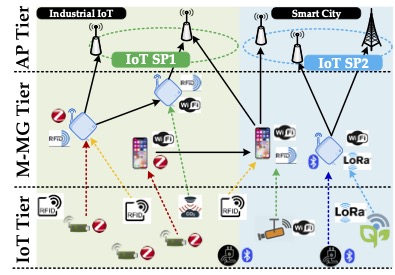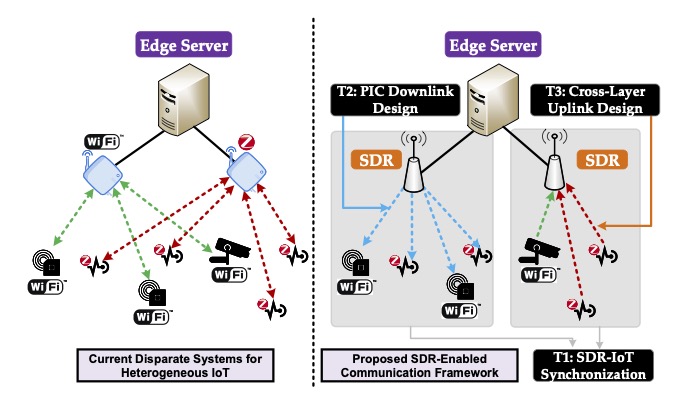Research Theme
Our main research areas are NextG wireless network, the Internet of Things (IoT), mobile computing, and heterogeneous edge computing with a focus on protocol, algorithm, and architecture design using trustworthy machine learning (ML) and artificial intelligence (AI) algorithms. The overarching goal of our research program is to make future heterogeneous networked systems efficient, scalable, and resilient through a combination of theoretical, simulation, and experimental studies.
Current Research Projects
- Research Overview
 Edge computing has promoted a plethora of emerging applications that benefit people's daily lives, mainly due to its salient features of enabling federated intelligence across geographically distributed edges. The key enabler to this success is the adoption of Federated Learning (FL) which increases the efficiency, accuracy, and scalability of learning algorithms deployed on distributed systems. When deploying FL to a practical edge computing system, achieving desired federated intelligence is always hindered by its heterogeneity in terms of both input data and system hardware. This line of research designs a parallel Grow-and-Prune (P-GaP) framework to allocate data to its favorable edges with the most efficient learning algorithm, anticipating finding the data-system-learning algorithm harmony for system-level training efficiency enhancement.
Edge computing has promoted a plethora of emerging applications that benefit people's daily lives, mainly due to its salient features of enabling federated intelligence across geographically distributed edges. The key enabler to this success is the adoption of Federated Learning (FL) which increases the efficiency, accuracy, and scalability of learning algorithms deployed on distributed systems. When deploying FL to a practical edge computing system, achieving desired federated intelligence is always hindered by its heterogeneity in terms of both input data and system hardware. This line of research designs a parallel Grow-and-Prune (P-GaP) framework to allocate data to its favorable edges with the most efficient learning algorithm, anticipating finding the data-system-learning algorithm harmony for system-level training efficiency enhancement. - Research Team
- Faculty, Dr. Linke Guo (Lead PI), Dr. Xiaolong Ma (Co-PI), and Dr. Jon Calhoun (Co-PI); Collaborator, Dr. Xiaonan Zhang, PI@Florida State University
- Student: Jingjing Fu@Clemson, Kaiyuan Deng@Clemson, Ruiwen Shan@Clemson, and Hansong Zhou@FSU
- Acknowledgement
This project is supported in part by the U.S. National Science Foundation (NSF) under the grant CCF-2312616 and CCF-2312617 ($1,200,000, 8/15/2023-8/14/2027). Any opinions, findings, and conclusions or recommendations expressed in this material are those of the author(s) and do not necessarily reflect the views of the NSF.
- Research Overview
 Given different data transmission and service requirements, various different wireless protocols have been developed and applied to IoT. This protocol heterogeneity issue has become the major stumbling block to the scalability of real IoT systems, such as industrial IoT, smart manufacturing, and connected healthcare. This research effort develops a novel network-layer design in a hierarchical architecture for current IoT systems, where an intermediate layer, i.e., mobile multi-protocol gateways (M-MGs), is introduced to help collect data from heterogeneous IoT devices. This project plans to provide a holistic approach to investigate the architecture design, resource management, and dependability enhancement for the newly proposed architecture.
Given different data transmission and service requirements, various different wireless protocols have been developed and applied to IoT. This protocol heterogeneity issue has become the major stumbling block to the scalability of real IoT systems, such as industrial IoT, smart manufacturing, and connected healthcare. This research effort develops a novel network-layer design in a hierarchical architecture for current IoT systems, where an intermediate layer, i.e., mobile multi-protocol gateways (M-MGs), is introduced to help collect data from heterogeneous IoT devices. This project plans to provide a holistic approach to investigate the architecture design, resource management, and dependability enhancement for the newly proposed architecture. - Research Team
- Faculty, Dr. Linke Guo (Lead PI); Collaborator, Dr. Beatriz Lorenzo, PI@University of Massachusetts Amherst
- Student: Jingjing Fu@Clemson, Zhuoyang Wang@Clemson, and H. H. Esmat@UMass
- Acknowledgement
This project is supported in part by the U.S. National Science Foundation (NSF) under the grant CNS-2008049 and CNS-2008309 ($565,400, 10/1/2020-9/30/2025). Any opinions, findings, and conclusions or recommendations expressed in this material are those of the author(s) and do not necessarily reflect the views of the NSF.
- Research Overview
 The proliferation of widely deployed Internet of Things (IoTs) has significantly increased the spectrum scarcity issue for emerging IoT applications that are hungry for spectrum resources, especially in the already-crowded Industrial, Scientific, and Medical (ISM) 2.4GHz. The prevalent wireless coexistence among those devices prevents advanced wireless technologies from fully unleashing their potentials, and thus becomes the major hindrance for scaling future heterogeneous IoT systems on 2.4GHz. This project envisions a novel communication framework that leverages Software-Defined Radios (SDRs) to act as gateways in the IoT systems for managing the device heterogeneity in terms of protocol stack, transmission power, and bandwidth. The proposed framework stems from hardware-level power-efficient SDR-IoT synchronization to software-defined signals for downlink transmission, and finally integrates hardware-software co-designs to achieve spectrum-efficient communication among heterogeneous IoT devices.
The proliferation of widely deployed Internet of Things (IoTs) has significantly increased the spectrum scarcity issue for emerging IoT applications that are hungry for spectrum resources, especially in the already-crowded Industrial, Scientific, and Medical (ISM) 2.4GHz. The prevalent wireless coexistence among those devices prevents advanced wireless technologies from fully unleashing their potentials, and thus becomes the major hindrance for scaling future heterogeneous IoT systems on 2.4GHz. This project envisions a novel communication framework that leverages Software-Defined Radios (SDRs) to act as gateways in the IoT systems for managing the device heterogeneity in terms of protocol stack, transmission power, and bandwidth. The proposed framework stems from hardware-level power-efficient SDR-IoT synchronization to software-defined signals for downlink transmission, and finally integrates hardware-software co-designs to achieve spectrum-efficient communication among heterogeneous IoT devices. - Research Team
- Faculty, Dr. Linke Guo PI@Clemson; Collaborator, Dr. Bayaner Arigong Lead PI@FAMU, Dr. Xiaonan Zhang, PI@Florida State University
- Student: Chenxu Jiang@Clemson and Shaoying Wang@FSU
- Acknowledgement
This project is supported in part by the U.S. National Science Foundation (NSF) under the grant CNS-2431440, CNS-2431438, and CNS-2431439 ($600,000, 10/15/2024-9/30/2027). Any opinions, findings, and conclusions or recommendations expressed in this material are those of the author(s) and do not necessarily reflect the views of the NSF.
- Research Overview
 With the increasing efficiency and product quality brought about by the Fourth Industrial Revolution (i.e., industry 4.0), the environmental sustainability challenges associated with upgrading the smart computing devices (e.g., Industrial Internet of Things -- IIoT) during industry expansion are becoming increasingly significant. The substantial increase in new device production and adoption inevitably leads to higher greenhouse gas (GHG) emissions, contributing to global warming, which in turn results in economic losses for industries. Existing lifecycle management practices often prioritize cost-effectiveness over sustainability or lack standardized metrics for assessing GHG emissions, posing challenges in achieving sustainability goals. This proposal outlines fundamental research that introduces a quantifiable lifecycle sustainability metric into industry computing system by proposing a novel Sustainable Revitalization framework, which will reduce the GHG emissions by enabling computing devices migration across service hierarchy.
With the increasing efficiency and product quality brought about by the Fourth Industrial Revolution (i.e., industry 4.0), the environmental sustainability challenges associated with upgrading the smart computing devices (e.g., Industrial Internet of Things -- IIoT) during industry expansion are becoming increasingly significant. The substantial increase in new device production and adoption inevitably leads to higher greenhouse gas (GHG) emissions, contributing to global warming, which in turn results in economic losses for industries. Existing lifecycle management practices often prioritize cost-effectiveness over sustainability or lack standardized metrics for assessing GHG emissions, posing challenges in achieving sustainability goals. This proposal outlines fundamental research that introduces a quantifiable lifecycle sustainability metric into industry computing system by proposing a novel Sustainable Revitalization framework, which will reduce the GHG emissions by enabling computing devices migration across service hierarchy. - Research Team
- Faculty, Dr. Linke Guo Co-PI; Collaborator, Dr. Xiaolong Ma PI, Dr. Chao Fan, Co-PI
- Acknowledgement
This project is supported in part by the U.S. National Science Foundation (NSF) under the grant CCF-2427875 ($299,994, 10/1/2024-9/30/2026). Any opinions, findings, and conclusions or recommendations expressed in this material are those of the author(s) and do not necessarily reflect the views of the NSF.
[NSF] Resilient Harmonious Federated Learning in Heterogeneous Edge Computing
[NSF] Scalable, Flexible, and Dependable Architecture Design for IoT
[NSF] Software-Hardware Co-design for Spectrum-Efficient Wireless Coexistence
[NSF] Sustainable Industrial Expansion via Computing/Communication Revitalization
[ARO] [U.S. Army GVSC] Explainable AI-based RF Sensing for NextG Security
The advent of next-generation wireless systems, such as 5G and the upcoming 6G networks, is revolutionizing connectivity with enhanced data rates, ultra-low latency, and large-scale device interconnections. Central to these successes are the holistic AI-driven security mechanism, which ensure the robustness, resiliency, and intelligence of the entire network infrastructure. Unfortunately, wireless devices, e.g., IoTs, usually operate in a harsh environment with the presence of adversarial disruption and denial, and thus the network performance and communication security will be compromised significantly. This line of research outlines novel adversarial attacks and further focuses on countermeasure designs.
[U.S. Army GVSC] Achieving Networked Autonomy in Zero Trust Environment
The 2022 DoD Zero Trust Strategy emphasizes that Zero Trust (ZT) principles need to be integrated into each cybersecurity functions (Identify, Protect, Detect, Respond, and Recover) and current security mechanisms which rely on trusted networks, devices, and processes must be replaced with multi-attribute-based confidence levels that accordingly determine the level of authorization and access. One core need for the successful implementation of ZT is to develop real-time risk-based response security solutions as the complexity of threats increases. Inspired by this guideline, we develop a trust monitoring and management framework that can operate on top of existing ROS-based vehicle systems to frequently verify the trustworthiness of all vehicles to adjust their levels of access and assigned tasks.
